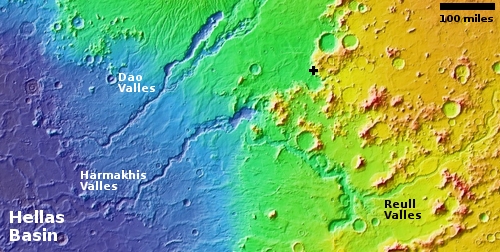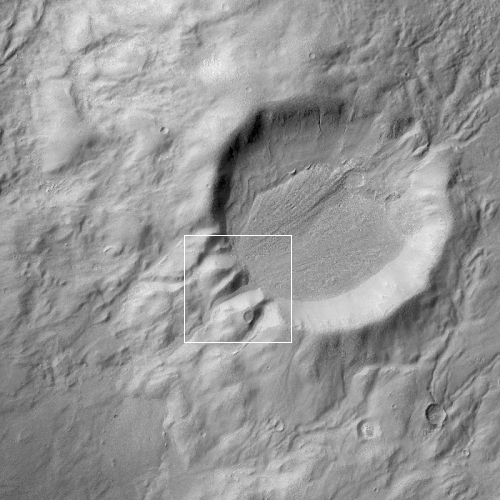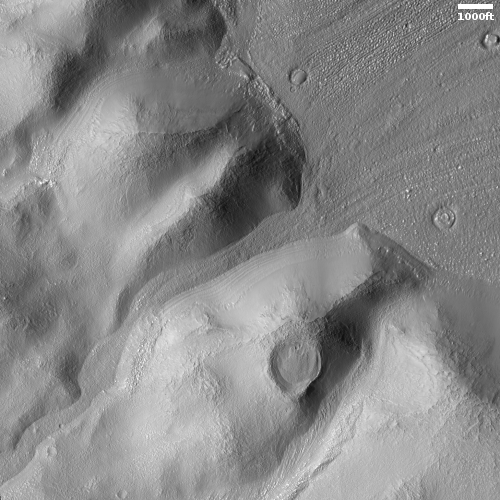Glacial flows pushing out through a Martian crater rim
Today’s cool image once again illustrates how Mars is far from a waterless planet. Instead, there is strong evidence that water ice can be found across most of the Red Planet’s surface, excluding the equatorial regions lower than 30 degrees latitude.
The photo to the right was taken on September 11, 2021 by the wide view context camera on Mars Reconnaissance Orbiter (MRO). It shows a 6-mile-wide unnamed crater on Mars, located at 35 degrees south latitude, with what appears to be a glacier in its interior, flowing to the southwest towards several breaches in the crater’s southwest rim. Several of those breaches now sit higher than the flow, suggesting that the glacier itself was once higher and flowed out of those gaps. Now the level has dropped, and the only place the glacier exits the crater is the central gap at the center of the white rectangle.
That white rectangle marks the area covered by a recent MRO high resolution image, taken on March 29, 2022 and cropped and reduced to post below.

The close-up clearly shows what looks like a very typical glacial flow exiting the crater at this gap and working its way to the southwest along the valley it has carved. The parallel lines visible on that valley’s southern slopes, as well as the older breaches to the north and south, further suggest that this glacier was once higher. Each line marks the passing of one Martian climate cycle, thought to be caused by the wide swings of the planet’s rotational tilt, from 11 to 60 degrees. When the planet’s tilt is low, the poles are warmer than the mid-latitudes. Water migrates from the poles to those mid-latitudes where it falls as snow on these glaciers to make them grow. When the planet’s tilt is high, the situation reverses, and the water sublimates from the mid-latitudes to the poles, and the glaciers begin to shrink.
Today, Mars is tilted 25 degrees, so scientists believe the situation is in a steady-state, with the glaciers neither growing nor shrinking.
The overview map to the right marks this crater’s location with the black cross. The cratered region to the east of Hellas Basin is one of several on Mars where scientists have detected large numbers of glacial features (see the global Mars map in this August 1, 2022 post). The photos of this crater are simply another example.
On Christmas Eve 1968 three Americans became the first humans to visit another world. What they did to celebrate was unexpected and profound, and will be remembered throughout all human history. Genesis: the Story of Apollo 8, Robert Zimmerman's classic history of humanity's first journey to another world, tells that story, and it is now available as both an ebook and an audiobook, both with a foreword by Valerie Anders and a new introduction by Robert Zimmerman.
The print edition can be purchased at Amazon or from any other book seller. If you want an autographed copy the price is $60 for the hardback and $45 for the paperback, plus $8 shipping for each. Go here for purchasing details. The ebook is available everywhere for $5.99 (before discount) at amazon, or direct from my ebook publisher, ebookit. If you buy it from ebookit you don't support the big tech companies and the author gets a bigger cut much sooner.
The audiobook is also available at all these vendors, and is also free with a 30-day trial membership to Audible.
"Not simply about one mission, [Genesis] is also the history of America's quest for the moon... Zimmerman has done a masterful job of tying disparate events together into a solid account of one of America's greatest human triumphs."--San Antonio Express-News
Today’s cool image once again illustrates how Mars is far from a waterless planet. Instead, there is strong evidence that water ice can be found across most of the Red Planet’s surface, excluding the equatorial regions lower than 30 degrees latitude.
The photo to the right was taken on September 11, 2021 by the wide view context camera on Mars Reconnaissance Orbiter (MRO). It shows a 6-mile-wide unnamed crater on Mars, located at 35 degrees south latitude, with what appears to be a glacier in its interior, flowing to the southwest towards several breaches in the crater’s southwest rim. Several of those breaches now sit higher than the flow, suggesting that the glacier itself was once higher and flowed out of those gaps. Now the level has dropped, and the only place the glacier exits the crater is the central gap at the center of the white rectangle.
That white rectangle marks the area covered by a recent MRO high resolution image, taken on March 29, 2022 and cropped and reduced to post below.

The close-up clearly shows what looks like a very typical glacial flow exiting the crater at this gap and working its way to the southwest along the valley it has carved. The parallel lines visible on that valley’s southern slopes, as well as the older breaches to the north and south, further suggest that this glacier was once higher. Each line marks the passing of one Martian climate cycle, thought to be caused by the wide swings of the planet’s rotational tilt, from 11 to 60 degrees. When the planet’s tilt is low, the poles are warmer than the mid-latitudes. Water migrates from the poles to those mid-latitudes where it falls as snow on these glaciers to make them grow. When the planet’s tilt is high, the situation reverses, and the water sublimates from the mid-latitudes to the poles, and the glaciers begin to shrink.
Today, Mars is tilted 25 degrees, so scientists believe the situation is in a steady-state, with the glaciers neither growing nor shrinking.
The overview map to the right marks this crater’s location with the black cross. The cratered region to the east of Hellas Basin is one of several on Mars where scientists have detected large numbers of glacial features (see the global Mars map in this August 1, 2022 post). The photos of this crater are simply another example.
On Christmas Eve 1968 three Americans became the first humans to visit another world. What they did to celebrate was unexpected and profound, and will be remembered throughout all human history. Genesis: the Story of Apollo 8, Robert Zimmerman's classic history of humanity's first journey to another world, tells that story, and it is now available as both an ebook and an audiobook, both with a foreword by Valerie Anders and a new introduction by Robert Zimmerman.
The print edition can be purchased at Amazon or from any other book seller. If you want an autographed copy the price is $60 for the hardback and $45 for the paperback, plus $8 shipping for each. Go here for purchasing details. The ebook is available everywhere for $5.99 (before discount) at amazon, or direct from my ebook publisher, ebookit. If you buy it from ebookit you don't support the big tech companies and the author gets a bigger cut much sooner.
The audiobook is also available at all these vendors, and is also free with a 30-day trial membership to Audible.
"Not simply about one mission, [Genesis] is also the history of America's quest for the moon... Zimmerman has done a masterful job of tying disparate events together into a solid account of one of America's greatest human triumphs."--San Antonio Express-News




Great stuff !! Love the photos. Thanks Mr. Z.
Then again, Yellowstone Lake was observed rising with no apparent inflow some time ago.
How could that be they asked ? …… then.
Mars, the next national park ! as the tee shirts say.
Love it.
A.